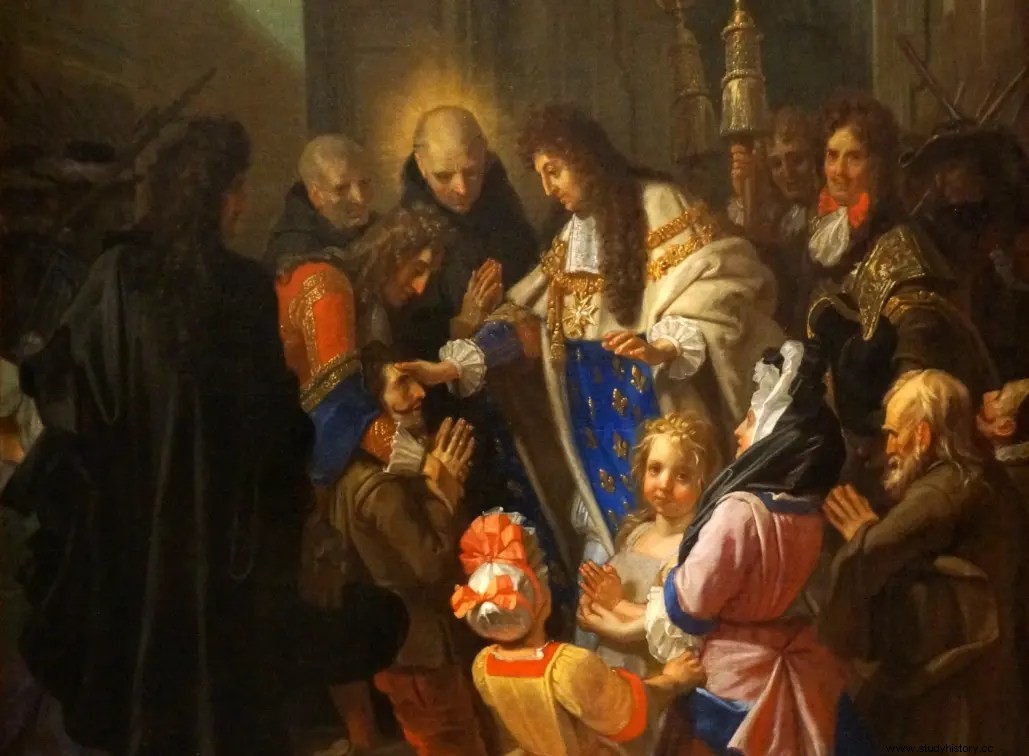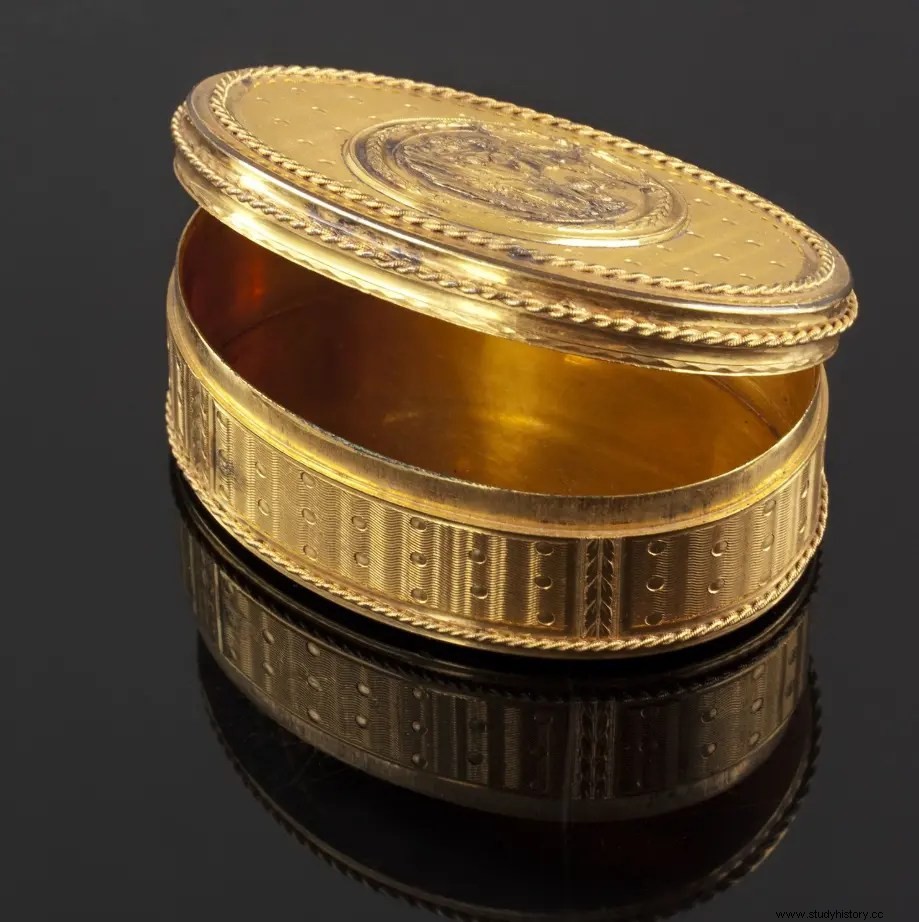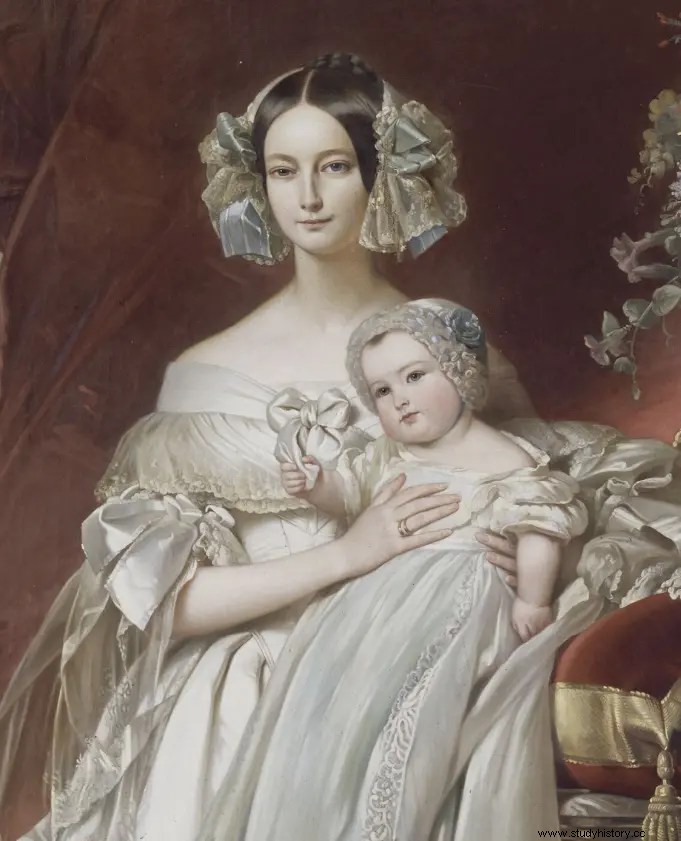Under the Ancien Régime, Christmas celebrations were above all religious celebrations intended for contemplation. Dangeau's description in his Journal of December 24 and 25, 1697 illustrates well the pious habits of the royal family at this time:
Tuesday 24, Christmas Eve:the king made his devotions in the morning. After dinner he heard vespers; then he made the distribution of the vacant benefices. At ten o'clock he returned to the chapel, and left it only after having heard the three midnight masses as he does every year. Monseigneur, his children, and Madame la Duchesse de Bourgogne attended all the devotions of the day. […] Christmas Day:the king heard high mass and attended all the devotions of the day. Monsignor and the princes his children attended with him.
It is also customary that on Christmas Eve (as on All Saints' Day, Easter and Pentecost), the king touches the patients with scrofula :at that time the population still believed deeply in the coronation (religious ceremony), which confers on the chosen one the power to cure this tuberculosis of the lymph nodes. Louis XIV also got into the habit of shutting himself up with his confessor Father La Chaise and often he worked late at night in the company of Madame de Maintenon and certain ministers. It is therefore in no way a festive evening... Besides, the monarch forbids games, shows and comedies during Advent!
His successor Louis XV was less strict:courtiers were asked to keep quiet only during Christmas Eve . The Duke of Luynes writes for example in his Memoirs in December 1743:
Tuesday, Christmas Eve, there was no comedy or play; it is the custom. The queen retired to her closets after she returned from church.
It is also a tradition that a sermon is given every Sunday of Advent and that a member of the Court does the collection Christmas Eve. In 1741, it was the turn of Madame de Chevreuse:“It was Madame de Chevreuse who collected; the total of the collection amounted to 45 louis. »

New Year's gifts
Under the Ancien Régime, presents were distributed not for Christmas but to celebrate the New Year. This is an opportunity for the king, queen and princes to show their gratitude or their friendship to the members of their house and the Court by presenting them with a piece of jewelery or giving them a certain amount of money:gifts . The 1 st January 1606, the Dauphin Louis, aged 5, is overexcited at the idea of being able to distribute presents to courtiers. His doctor says:
Dressed in his coat, combed his hair, combed peacefully for what he was told not to do the stubborn on the first day of the year, for fear of being so all year round. He holds Madame de Montglat's muff, and goes to each one, slapping them gaily and smiling, saying:Here, here are your New Year's gifts, and as if ashamed of having nothing to give to those who asked him. Blue ribbon is brought to him; he gives it to many.
The following year, on December 26, he asked to write:“I want to write a little book that I want to have printed, to send to dad [Henri IV] for his Christmas gifts. »
The practice gained importance under Louis XIV . On December 31, 1699, the king did not hesitate to analyze with his critical eye the gifts that the courtiers were going to offer to the wife of his grandson:
In the evening, at Madame de Maintenon's, all the ladies of Madame the Duchess of Burgundy had the gifts carried in a large manna what they did to this princess for her New Year's Eve. The king took the trouble to open and see everything, and found the presents very well chosen.
Louis XIV very often gives money that his relatives are happy to spend as they please! His sister-in-law Elisabeth-Charlotte, a great collector of medals, wrote to the Duchess of Hanover on January 10, 1700:
Certainly I have to thank you for these beautiful medals! You cannot imagine what amusement it is for me. I spend whole days looking at them, as also my antique medals. Last Monday I again bought one hundred and fifty with the money the king gave me for my New Year's gift.
The Sun King also got into the habit of ordering golden snuffboxes from the Menus Plaisirs administration for the occasion. . A ritual maintained under Louis XV, who, for example, made a present to his wife in January 1746:
Yesterday the King gave a gift to the Queen, which he had not done for several years; it is a small enameled gold snuff box, in which there is a watch on one side.

Marie Leszczynska loves this practice of New Year gifts . She offers it to all the people she esteems. Thus to Madame de Luynes, "a gold snuff box encrusted with corsalines in the shape of perfectly beautiful cherries".
If the golden snuffboxes are therefore always present, more original or more sumptuous presents are also distributed, and sometimes in advance, thus approaching the date of Christmas. December 31, 1744:
Yesterday the king gave presents to Mesdames [his daughters]; one, a pair of diamond earrings, the other a rock crystal cellar.
Two years later, the queen sent to the domain of Choisy where her husband resided “two very beautiful terrines of Saxony porcelain, which she had delivered to M. de Coigny; they were presented to the king without saying from whom they came; this present has been very successful ". The following year, the king, keen on science, gave his wife a very beautiful clock that played 13 tunes , to decorate their cabinets.
A very late Christmas tree!
From the reign of Henri IV, the custom of the log is attested. The latter then has nothing to do with a cake! This is a real wooden log or “stump” that are thrown into the fire on Christmas Eve. The doctor of the young Dauphin, future Louis XIII, testified on December 25, 1605:
Le Borgne [a servant] arrives, the Dauphin sees him putting logs on the fire, says that it's the coming of Christmas, especially since the day before, before supper, he saw the Christmas stump put, where he danced and sang at the coming of Christmas.
However, no tree. The custom of decorating a tree for Christmas comes from Germany and Eastern European countries. In the XVIII th century, this tradition is not at all in the mores of the French! The Germanic princesses who arrive at Versailles are surprised. One of the first to try to spread this folklore at Court was a Bavarian princess:Elisabeth-Charlotte , second wife of Mr. brother of Louis XIV. In December 1708, in a letter to her daughter who had become Duchess of Lorraine, she recounted with nostalgia her Christmases in Hanover:
I don't know if you have another game still made in Germany called Christkindl , as the Christ child would say, where tables are set up like altars and furnished for each child with all sorts of things, new clothes, money, silk, dolls, candy, and all sorts of things. We put boxwood trees on these tables, and to each branch we attach a small candle:it has the prettiest effect in the world.
Madam's attempt is a failure , as she confessed to Sophie de Hanover in a letter of January 1711, after having once again recalled her memories:“Here we know nothing of all that. I wanted to introduce it, but Monsieur said:You want to give us some of your German fashions to save money. » »
And it was certainly not the "very Catholic" Madame de Maintenon who was going to support the "pagan custom" of her worst enemy...
Legend has it that Marie Leszczynska , on his arrival in France, finally succeeds in establishing the custom by having a tree decorated at the Palace of Versailles. The thing seems unlikely. No reliable source seems to confirm this fact. One of the queen's main courtiers and great memoirist of the time, the Duke of Luynes, makes no mention of it. No more than the Duke of Cröy in his fabulous Journal , nor even the press of the time. Such an event, totally incongruous, would not have gone unnoticed! But under Louis XV, it was another kind of queen, a queen of hearts (very French this one!) who set the tone:the Marquise de Pompadour.

It was actually necessary to wait for the arrival of another German princess to see this tradition become popular at the Court. Helen of Mecklenburg arrived in France in 1837 to marry the Duke of Orleans, eldest son of King Louis-Philippe. She has wonderful memories of Christmases spent with her family, when her parents and brothers and sisters met in Friedensburg around the Christmas tree to exchange their presents... The day after Christmas 1837, the first she spent in France, the Duchess of Orléans writes to her delighted mother:
On Christmas Eve, the good queen [Marie-Amélie de Bourbon] had given me a surprise, by garnishing secretly a beautiful tree that was placed in my white living room, so that it reminded me of Germany.
A tradition that seems to have settled in the circle of the royal family , since the 1 st January 1844, when Hélène was already a young widow after the accidental death of her husband, she wrote again to her mother:
We have, as before, ended the year with the king, under the illuminated tree. The children were delighted with their gifts.
Lean meals and fatty meals
On Christmas Eve, the royal family eat lean:fish, soups, and seafood. This is probably where the tradition of eating oysters comes from. for the parties ! After mass, everyone takes a larger meal, the period of fasting is over:the fatty meal. We eat a lot of suckling lamb and especially poultry, which is more noble:goose, capon and of course turkey . The latter appears in France in the 16th century and comes from the Spanish Indies (the Americas), hence its name:the hen of India, the turkey! Exotic and therefore rare, it soon supplants the goose at the table of kings. The meats are often stuffed and truffled.
Another traditional Christmas dish that would have appeared at the Court of the Sun King:chestnut icing . The exact origin is a little vague, it is however certain that Louis XIV and his courtiers are crazy about it, especially for Christmas. The French Pierre de La Varenne, cook of the Marquis d'Uxelles in Châlon-sur-Saône (near Lyon) reveals a recipe in his book Le Parfait Confiturier published in Paris in 1689 with privilege of the king:
Bake chestnuts as usual; being cooked, peel them and flatten them a little between your hands:arrange them on a plate, and take water, sugar, lemon juice or orange flower water, make a syrup, being done, pour the whole boiling over your chestnuts, and serve them hot or cold.
